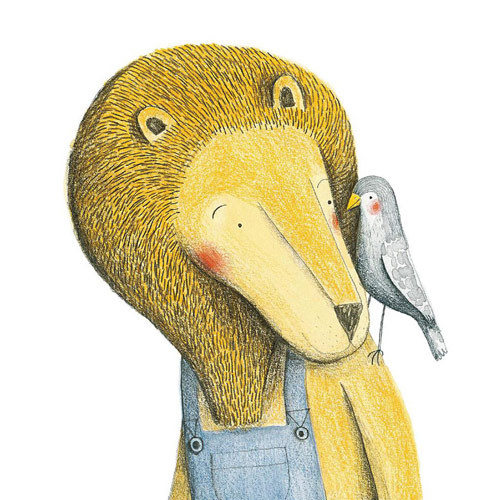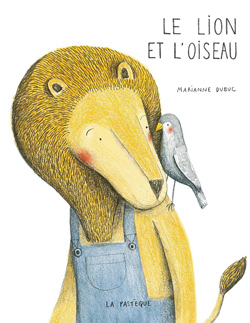< Back to posts
Marianne Dubuc
Canada

Marianne Dubuc received her degree in graphic design from the University of Quebec, Montreal. She's created many different kinds of books for readers of all ages, and her work has been published in fifteen countries. In 2014, The Canada Council for the Arts awarded Marianne a Governor General's Literary Award.
In this post, Marianne talks about the creation of her award-winning picturebook, ‘Le Lion et l'oiseau’ (The Lion and the Bird). This enchanting story was first published in French by Éditions de La Pastèque, and has been translated into many languages.
Marianne: ‘The Lion and the Bird’ was written in a few minutes. This is often how my stories come to life: writing really quickly what comes into my mind. It can take a few hours, days, months or even (as in this case) years for the story to start forming clearly in my head – but once this happens, I have to write it down very quickly or it will drift away.
When I'm searching for a new book idea, I usually write continuously in a notebook, as if I were talking to it. It's a little bit like automatic writing, where you write everything that comes into your mind, without censoring yourself. That is how my brain feels free to create stories. It's very funny to go back to my old notebooks and see all the stories that I've started. Some are good – others are horrible.
I tend to see my stories in images before I write them down in my notebook. At this stage, I rarely write the actual text that will be read in the book – that part comes later in the process. I simply write the story as it comes to me, as if I were telling it to someone.
My first published book was ‘La mer’ (The sea) – a wordless picture book about a cat who follows a winged fish on a long adventure.
The publisher, Éditions de La Pastèque, asked me if I had another project, but having children and making other books took a lot of my time... so years passed before I had a new idea to present to them. It was really important to me that my next project with La Pastèque was a strong one, since ‘La mer’ was my favourite book, and I wanted to make another one in the same spirit.
I knew I wanted to write a story about two characters – two friends – and that they would be animals. I always tell stories with animal characters in them. I don't like to draw humans; I haven't found a way to draw them that satisfies me yet. I think that when drawing animals, I give myself more freedom of interpretation than I do with humans.
‘The Lion and the Bird’ is the story of a Lion who finds a wounded bird on a chilly autumn day. The bird's flock is flying south for the winter, but he can't go with them because his wing is broken. Lion takes Bird to his house, and they pass the long winter months together, happy to have each other. But in the spring, the other birds return. Bird has to decide whether he should fly north with his family or stay with Lion.
Growing up as an only child, my family and friends were really important to me. With many of them, we've grown apart for different reasons; some of them moved away (or I moved away) and others simply changed. C'est la vie. ‘The Lion and the Bird’ is about life's way of taking people away from the ones they love. It's also about letting go of the ones you love, and having faith in life's way of sending them back your way some day.
One day, many years ago, I was sad because I felt I was slowly losing one of my best friends. My mother told me (I remember her exact words): “Marianne, sometimes in life people drift apart. But you'll see... you might cross them in the street ten years from now, and your friendship will come back as if nothing ever happened.” And that is exactly what happened for me with this particular friend... and it's what I hope will happen with other people who are no longer in my life.
When I wrote the story for ‘The Lion and the Bird’, I actually saw the book in images first. It usually happens this way when I create a book. I knew I wanted to add words, but not too many. I wanted the text and the images to work together, with the words adding just what was needed so the story would be threaded from beginning to end. I am particularly fond of wordless picture books. I like the openness they give to the readers to interpret the story in their own way.
So my intention for ‘The Lion and the Bird’ was to create the story with images and add the text afterwards. I had no idea if this would work the way I intended it to, but it actually did. It even surpassed my expectations. I realised that the absence of words and the silences that come throughout the story leave space for the readers' emotions and interpretations. I think this is why the book touches so many readers.
I like the following image because to me it expresses the calm contentment of being with someone you're happy with. It seems like a nice place to be.
As I wrote the book, I wanted it to be full of silences. There had to be a rhythm: the rhythm of time and of the seasons passing. This is expressed in many ways. For example, some pages might have only two or three words, or none at all, and there are two completely blank spreads in the middle of the book, representing the passing of the long months of winter (I live in Quebec, where winter lasts forever!). But I guess it's hard to explain this simply in words – and I think in order to understand the importance of the rhythm of this book, you would need to read it.
I made the rough drawings for the book using a graphics tablet. I don't usually use those devices because I feel it changes my style; I prefer to use my mechanical pencil. But this way is quicker for touch ups. I actually like the style of these roughs. It might be something I could try for a book in the future.
I used watercolour and pencil to do the illustrations. I have always preferred my roughs to my final images. I find them more spontaneous (I think I am not the only illustrator to say this!). In this book, I tried a new technique: I did the watercolour first, then I drew all of the black lines on top using a 2B mechanical pencil. This technique gave me a chance to draw spontaneously, knowing I could erase the pencil if I made a mistake. I also used some wood colouring pencils, which is usually my main medium.
Illustrations © Marianne Dubuc. Post edited by dPICTUS.
Le Lion et l'oiseau /
The Lion and the Bird
Marianne Dubuc
Éditions de La Pastèque, Canada, 2013
One autumn day, Lion finds a wounded bird in his garden. With the departure of the bird's flock, Lion decides that it's up to him to care for the bird, and the two become close friends. Nevertheless, the bird departs with his flock the following autumn. What will become of Lion and what will become of the friendship?
‘... ineffably wonderful – the kind of treasure to which the screen and the attempted explanation do no justice.’
—Brain Pickings
- French: La Pastèque
- English: Enchanted Lion Books (USA) — Book Island (UK, AUS, NZ)
- Dutch: Querido
- Portuguese (Brazil): Editora Positivo
- German: Carlsen Verlag
- Italian: Orecchio Acerbo
- Spanish: Tramuntana
- Korean: EntersKorea
- Greek: Nefeli Publishing
- Chinese: Juvenile & Children’s Publishing House


















